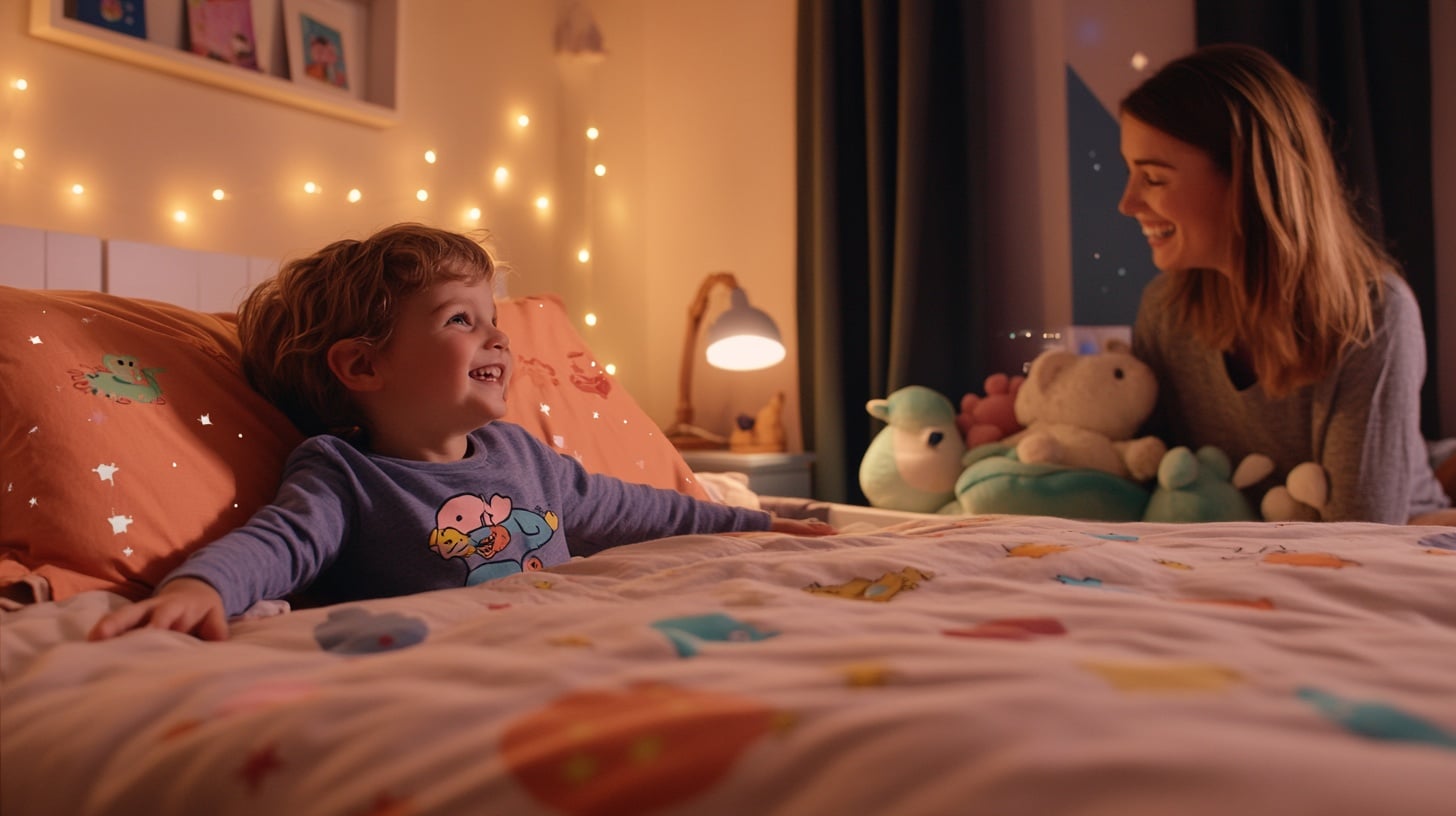When my first baby was born, I didn’t plan on co-sleeping, but after a few sleepless nights, it felt like the easiest way for both of us to get some rest.
I loved having my little one close, hearing those tiny breaths, and knowing they were safe. But as time went on, I started to realize that none of us were getting the best sleep.
My baby would wake at every movement, and I couldn’t relax, constantly worried about rolling over or disturbing their sleep.
When my second baby arrived, I knew I had to transition them to their own sleep space sooner. But let me tell you, it wasn’t easy.
There were tears (from both of us), moments of doubt, and nights when I thought about giving up. If you’re going through this, you’re not alone.
Co-sleeping is common, and many parents struggle with making this change. The good news? With patience, consistency, and a bit of flexibility, your baby can learn to sleep independently—and so can you!
How to Stop Co-Sleeping?
As a mom who’s been through the co-sleeping transition, I know exactly what you’re dealing with. Breaking the co-sleeping habit isn’t easy, but with patience and consistency, it’s definitely possible. Let me share what worked for my little one and me.
Why I Decided to Stop Co-Sleeping?
Like many of you, I cherished those nighttime cuddles with my child. But reality hit when I noticed both of us struggling with sleep quality.
My little one would constantly wiggle around, and I’d often wake up with either tiny feet in my face or hanging off the edge of the bed!
The lack of proper rest started affecting our daytime moods, and I realized we needed a change.
After talking with our pediatrician and doing some research, I understood that helping my child sleep independently would benefit their development and our overall well-being.
Start with Baby Steps
The key to our success was taking it slow and steady. I started by creating a cozy space in their room that felt special to them.
We went shopping together for soft bedding, picked out their favorite character pillowcases, and set up a gentle night light. During daytime hours, we’d spend time playing in their room to build positive associations.
We began with afternoon naps in their bed, making it feel like an adventure rather than a punishment. This gradual approach helped them see their room as a safe, comfortable space.
Create a Bedtime Routine That Works
Our turning point came when we established a consistent bedtime routine. It starts with a warm, calming bath around 7 PM, followed by changing into cozy pajamas.
Then, we spend time reading their favorite stories – usually two or three books – while cuddling in their room. We talk about the best parts of our day and do some gentle stretching exercises.
The routine ends with a special “goodnight song” and our secret handshake. This predictable sequence signals their brain that it’s time to wind down and sleep.
Dealing with Middle-of-Night Visits
Let me be real, those midnight visits can test your patience! When my little one would appear at my bedside, I’d calmly walk them back to their room without starting a conversation.
I found that keeping the lights dim and speaking softly helped maintain the sleepy atmosphere.
If they were scared, I’d do a quick “monster check” and remind them of their brave superhero status.
Sometimes, I’d sit near their bed for a few minutes, gradually moving farther away each night until they felt secure sleeping alone.
Celebrate Small Wins
Making progress deserves recognition! When my child stayed in their bed until morning, we’d celebrate with their favorite breakfast and lots of high-fives.
We created a sticker chart where they could track their “sleep victories.” After collecting enough stickers, they could choose a small reward like a new book or extra playground time.
These celebrations made independent sleeping feel like an achievement rather than a chore. The excitement of earning stickers often outweighed their desire to sleep in my bed.
Be Patient with Yourself
This journey isn’t always smooth sailing, and that’s perfectly normal. There were nights when I felt discouraged, especially during sleep regressions or when they were sick.
I learned to forgive myself for the occasional setback and remember that progress isn’t linear.
Some children take longer to adjust, and that’s okay. The key is staying consistent with your approach while showing lots of love and understanding.
Remember, you’re teaching them a valuable life skill, even if it feels challenging right now.
I hope these tips help you navigate your own co-sleeping transition. Every child is unique, so feel free to adapt these suggestions to fit your family’s needs.
Trust your instincts, stay patient, and celebrate each step forward. You’re doing a great job, mama.
Understanding Why You Might Want to Stop Co-Sleeping
As a mom who’s been through this journey, let me share my personal experience about why transitioning from co-sleeping can be beneficial for both you and your child.
The Benefits of Independent Sleep for Your Child
When I first moved my little ones to their own bed, I noticed remarkable changes in their development.
They started learning how to self-soothe – something they couldn’t do while sleeping next to me.
Instead of relying on my touch or presence to fall back asleep, they began developing their own comfort strategies, like hugging their favorite stuffed animal or using gentle breathing techniques we practiced together.
Their sleep quality improved significantly, too. Without the distraction of my movements or the warmth of my body, they started sleeping more deeply and for longer stretches.
I noticed they were more refreshed in the morning, had better moods throughout the day, and even showed improved concentration during preschool activities.
The independence they gained went beyond just sleep. Their confidence grew as they mastered this new skill.
I remember how proud they were telling their grandparents, “I sleep in my big-kid bed now!”
This newfound independence also positively affected other areas of their development – they became more willing to try new things and handle other challenges with greater confidence.
The Benefits for Parents
Let me be honest – the benefits for us parents are just as significant! After months of sleeping in awkward positions and constantly being on alert, getting my own sleep space back was revolutionary.
I could finally stretch out, adjust my blankets without worry, and even read a book before bed if I wanted to.
The quality of my sleep improved dramatically. No more tiny elbows in my ribs or midnight kicks to my back!
Better rest meant I had more energy during the day, was more patient with my child, and could be more present in our daily activities together.
Having personal space again helped me feel more like myself. I could have uninterrupted conversations with my partner after our child’s bedtime, creating much-needed adult time.
This strengthened our relationship and helped maintain a healthy family dynamic.
The boundaries we established through independent sleeping also created a framework for other healthy habits.
It became easier to set and maintain other routines, like mealtime schedules and playtime limits. My child began to understand that different times of day have different purposes and that sleep time is special and important.
Most importantly, this transition helped me be a better parent. With more rest and personal time to recharge, I found myself more energetic and creative in our daytime interactions.
Instead of feeling drained from broken sleep, I could fully engage in playtime, learning activities, and those precious moments of connection that make parenting so rewarding.
Remember, mama, while these benefits are significant, every family’s journey is unique. The key is finding what works best for you and your little one, moving at a pace that feels right for your family.
When Is the Right Time to Stop Co-Sleeping?
The right time to stop co-sleeping depends on your child’s readiness and your family’s situation.
Look for signs like your child falling asleep without needing to be held, showing interest in a “big kid” bed, or becoming more independent during the day.
Age plays a role too, by around three years old, many children are developmentally ready for their own sleep space.
Choose a stable period without big changes, like starting school or welcoming a sibling, to make the transition easier.
Ultimately, trust your instincts and move at a pace that feels right for both you and your child.
Signs Your Child Is Ready for the Transition
I remember feeling unsure about when to start this journey, but my little one actually showed me some clear signs.
The biggest clue was when they started falling asleep during storytime without needing to be in my arms.
They also began showing more independence in other areas of life – getting dressed by themselves and exploring their surroundings with confidence.
One day, they got super excited about a “big kid” bed they saw at their friend’s house. That enthusiasm was a golden opportunity!
They started talking about having their own special sleep space and would sometimes drift off for naps in their play area rather than seeking me out.
I also noticed they were developing better emotional regulation skills during the day. They could calm themselves down after minor upsets and didn’t always need immediate physical comfort.
These were all signs that they were building the skills needed for independent sleep.
Factors to Consider Before Making the Change
Looking back, I realized the timing wasn’t just about my child’s readiness but our whole family’s situation.
The first thing I considered was their age and developmental stage. Around age three, they started understanding simple explanations about sleep and could follow two-step bedtime instructions, which made the transition smoother.
Our family’s schedule played a big role, too. I waited until we had a relatively stable period – no major changes like starting school or welcoming a new sibling.
This stability gave us the mental space to focus on this transition without added stress.
I also made sure my partner and I were both ready for the change. Some nights would be challenging, requiring extra patience and consistency from both of us.
We needed to be united in our approach and prepared for some temporary sleep disruption.
The setup of our home was another consideration. We took time to create a sleep-friendly environment in their room, with proper temperature control, darkness levels, and safety measures in place. This preparation helped us feel more confident about the transition.
Most importantly, I checked in with my own emotional readiness. While co-sleeping had its challenges, it had also been a special bonding time.
I needed to feel genuinely ready to encourage this new phase of independence, knowing it was the right choice for our family’s well-being.
Remember, every family’s timeline is different. Trust your instincts about when the time feels right for you and your little one.
There’s no universal “perfect age” – it’s about finding the right moment when both you and your child are ready for this important step forward.
Preparing for the Transition
When I decided it was time to stop co-sleeping, I learned that preparation was key to making this big change smoother for everyone involved. Let me share how I approached this important transition with my little one.
Talk to Your Child About the Change
I remember sitting with my child during a calm moment after lunch, their favorite stuffed bunny in hand, as we talked about the upcoming change.
Instead of making it seem scary, I turned it into an exciting adventure. “You’re getting so big now! Soon you’ll have your very own special sleeping space, just like mommy and daddy.”
We read books about children sleeping in their own beds and made up stories about their toys having cozy bedtime routines.
I made sure to address their worries with patience: “Even though we’ll sleep in different beds, I’ll always be nearby if you need me.”
We practiced with daytime “pretend sleep” sessions, making it feel more like a game than a big change.
Create a Comfortable Sleep Space
This was honestly one of the most fun parts of our transition! We went shopping together, and I let my little one pick out their own bedding – they chose one with their favorite cartoon characters.
Seeing their eyes light up while selecting their own special pillowcase made me realize they were getting excited about their new sleep space.
We worked together to make their room feel magical. They helped choose a star-shaped night light that cast gentle patterns on the ceiling.
We arranged their stuffed animals like a protective sleep crew and hung family photos where they could see them from their bed.
Adding their favorite books within reach and a soft rug beside the bed made the whole room feel like their own cozy haven.
I also made sure the room was sleep-friendly – installing blackout curtains, setting up a white noise machine, and keeping the temperature comfortable.
We even created a special “brave kid corner” with a dream catcher they helped make. Every little touch helped them feel more secure and excited about their new sleeping arrangement.
Remember, involving your child in these preparations helps them feel more in control of the change.
Their excitement about their new sleep space can help overcome any anxiety about the transition.
Take it from this mama, the more they feel like it’s their special place, the smoother the transition will be.
Practical Steps to Stop Co-Sleeping
After trying different approaches with my own child, I discovered some methods that actually work. Let me share these practical steps that helped us transition successfully.
Gradual Transition Method
This gentle approach worked wonders for us! We started by having my little one fall asleep in their own bed for the first part of the night.
I’d tell them, “Let’s try sleeping in your big-kid bed until the moon is high in the sky!” At first, they’d usually end up in my bed around midnight, and that was okay.
Gradually, we extended the time. I used a sticker chart to track their progress – one sticker for making it to midnight and two for staying until morning!
What really helped was telling them they could come to my room for morning cuddles as soon as the sun came up. This gave them something to look forward to and made the separation feel less scary.
Chair Method
This method was a game-changer for us! I started by sitting in a comfy chair right next to their bed. Each night, I’d move the chair a tiny bit further away.
I’d say, “Mommy’s still here, keeping you safe.” The key was staying quiet – no chatting or playing – just being a calming presence.
Every few nights, I’d move the chair closer to the door. My little one could still see me but learned to fall asleep without needing me right beside them.
When they’d get anxious, I’d whisper, “You’re so brave, and I’m right here.” After about two weeks, I was able to sit outside their room, and eventually, they felt secure enough to fall asleep on their own.
Stay Consistent with a Bedtime Routine
Our bedtime routine became our secret weapon! We kept it simple but special: bath time with their favorite rubber duck, putting on cozy pajamas, brushing teeth together (making silly faces in the mirror), reading two stories in their special reading nook, and ending with our special “sleepy time” song.
The routine helped signal their brain that sleep time was coming. We stuck to the same order every night, even on weekends.
What made it work was keeping the timing consistent – starting at 7:00 PM meant they were usually drowsy by 7:45 PM.
I found that when we followed this routine faithfully, bedtime battles decreased significantly.
Dealing with Resistance and Setbacks
As someone who’s been through countless midnight wake-ups and “Mom, I’m scared” moments, I’ll share how I handled these challenging situations while staying calm (most of the time).
What to Do If Your Child Returns to Your Bed
Those tiny footsteps at 2 AM? Oh, I know them well! When my little one would appear beside my bed, I learned to handle it without drama.
I’d quietly take their hand and walk them back to their room, keeping the lights dim and my voice soft. “Let’s get you tucked back into your cozy bed,” I’d whisper.
Sometimes, they’d come back five times in one night – exhausting, yes, but consistency was crucial. I made a point to never scold them or show frustration.
Instead, I’d remind them, “You’re safe in your bed, just like we practiced.” I found that getting angry or giving in only confused them about our expectations.
I made their return trips boring (no fun conversations or snuggles) but always loving. A quick back rub, a gentle tuck-in, and a quiet “I love you” before leaving.
When they stayed in their bed all night, we’d celebrate with special morning pancakes or extra playtime.
Handling Night Wakings
Night wakings were tricky, but I discovered that comforting them in their own space made a huge difference.
When they’d call out, I’d go to their room instead of bringing them to mine. I’d sit on the edge of their bed, pat their back gently, and reassure them with simple phrases like “You’re safe” or “Everything’s okay.”
I learned to address their specific fears without making a big deal about them. If they were scared of shadows, we’d do a quick “brave check” of the room.
If they wanted water, we had a small cup ready on their nightstand. The key was keeping these interactions brief and calm, helping them feel secure without turning it into a long ordeal.
For those extra tough nights (like during thunderstorms or when they weren’t feeling well), I’d stay in their room a bit longer but still avoided taking them to my bed.
Sometimes, just knowing I was nearby helped them drift back to sleep in their own space.
Remember, setbacks are normal – especially during big changes, illnesses, or transitions. Stay patient and consistent, and you’ll get back on track.
You’re teaching them valuable skills, even on the tough nights!
Conclusion
We’ve covered why parents choose to stop co-sleeping and how to make the transition smoother for your little one.
It’s important to remember that this process takes time, patience, and a lot of love. There will be nights when things don’t go as planned, and that’s perfectly normal.
Your child is learning a new skill—sleeping independently—and just like any new milestone, it takes practice to master.
Don’t be discouraged if there are setbacks. Some nights might feel like you’re starting over, but consistency is what makes the biggest difference.
Keep reinforcing your bedtime routine and offering comfort in your new sleep space. Eventually, your child will adjust, and you’ll both sleep better.
Most importantly, trust your instincts. You know your child best, and every family’s journey will look different.
Be patient with yourself and your baby. I’d love to hear how your transition is going. Share your tips or challenges in the comments—let’s support each other through this big step in parenting!
Frequently Asked Questions
How Long Will the Transition Take?
Every child is different! From my experience, a successful transition typically takes 2-4 weeks for most children.
Some adjust within a few days, while others might need a couple of months. The key is staying consistent with your approach.
My little one took about three weeks to fully adjust, with gradual improvements each night.
What if My Child Has a Major Sleep Regression During the Process?
Sleep regressions are completely normal! When this happened with my child, we stuck to our routine but added extra comfort measures.
Sometimes, taking a step back temporarily (like sitting closer to their bed for a few nights) helped us get through rough patches. Remember, regression doesn’t mean failure – it’s just part of the journey.
When Should I Start the Transition if I’m Expecting Another Baby?
Start at least 2-3 months before the new baby arrives or wait until 2-3 months after. We began our transition well before my second pregnancy to avoid my firstborn feeling “replaced” in our bed.
This timing gives your child enough time to adjust without feeling pushed out because of the baby.
What if My Partner Disagrees with Stopping Co-Sleeping?
Open communication is crucial. My partner and I had different views initially, but we discussed our concerns and agreed on a plan that felt right for our family.
Consider talking to a pediatrician together or reading about sleep transitions to make an informed decision as a team.
Is it Normal for My Child to Be More Clingy During the Day?
Absolutely, During our transition, my child wanted extra cuddles during daytime hours. This is their way of ensuring the connection is still strong.
I made sure to provide plenty of physical affection and one-on-one time during the day, which actually helped them feel more secure at night.












